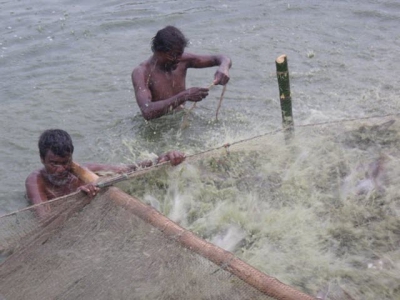Study sheds new light on intensification of aquaculture

Relatively simple changes to fish farming technology and management practices could help the global transition to increasingly intensive forms of aquaculture become more sustainable, according to new research.
Harvesting pangasius in a relatively intensive aquaculture system in Bangladesh. © Ben Belton
A recent lifecycle assessment (LCA) study of 2,678 fish farms in Bangladesh reveals that intensification – measured in material and economic output per unit primary area farmed – of aquaculture has more complex consequences for sustainability than previous studies have suggested.
“Most assessments of the potential for sustainable intensification rely on only one or two indicators, meaning that ecological trade-offs among impact categories that occur as production intensifies may remain unaccounted for. The present study addresses this limitation using LCA to quantify six environmental impacts from farming systems operating across a broad spectrum of intensities in Bangladesh; identify environmental trade-offs between technologies and among impact categories; and pinpoint the most efficient impact mitigation strategies,” explains the study’s lead author, Patrik Henriksson of Stockholm Resilience Centre and WorldFish.
The farms analysed in the study produced seven different fish groups: carp (Cyprinidae), tilapia (Oreochromis spp.), pangasius (Pangasius hypophthalmus), koi (Anabas testudineus), small indigenous fish species (SIS), freshwater prawn (Macrobrachium rosenbergii), and shrimps (mainly Penaeus monodon).
“LCA shows that the impacts of intensification are more complex that other studies have suggested, with our research showing that intensification results in increased acidification, eutrophication and ecotoxicological impacts in aquatic ecosystems, but with no influence on global warming or land use, and even positive consequences for freshwater consumption” says Henriksson.
The study also highlights how intensification is coupled with increasing geographical dispersal of environmental impacts.
“As production intensifies, the geographical locations of greenhouse gas (GHG) emissions, acidifying emissions, freshwater consumption, and land occupation shift from the immediate vicinity of the farm to more geographically dispersed locations,” Henriksson explains.
“The intensification of aquaculture has not resulted in escalating consequences across all environmental impacts and may help to reduce certain impacts. This is a positive note as we need to produce more while conserving our remaining wilderness” Henriksson reflects.
Moreover, as the authors note, intensification of food production systems – including aquaculture – is necessary to feed a rapidly expanding global population.
“A growing body of literature calls for us to try to produce more food while using fewer resources. And identifying the most sustainable intensification options for aquaculture provides an opportunity to avoid some of the environmental pitfalls of agriculture and livestock production. After all, fish farming has the potential to contribute to the sustainability of global food systems as a whole, given that many aquatic animals convert agricultural and livestock by-products into edible fish protein more efficiently than terrestrial animals,” Henriksson argues.
Mitigation strategies
The study also points out that there are also ways to help minimise the environmental impacts of intensification.
“In terms of feeds, improvements in feeding efficiency are vital and can be achieved by a variety of means, including better feed formulation, use of appropriate feed servings and better on-farm feed management practices,” says Henriksson.
“Equally fish survival – and thereby feed efficiency – can be improved by minimizing predation, maintaining water quality, providing effective disease diagnostics and access to veterinary advice, and improvements in overall farm management,” he adds.
The species and strain of fish should also be taken into account.
“Choice of species farmed is one of the most important factors influencing both feeding requirements and survival. Species choice and size also influences edible yield and duration of the production cycle. Grow-out times, in turn, govern both methane emissions from ponds and water losses through evaporation. Genetically improved strains of fish and shrimp also have considerable potential to improve feed conversion rates and overall environmental performance,” he points out.
The choice of equipment used can also have an impact.
“Aeration technologies promote aerobic digestion of organic material that can reduce methane emissions, but doing so will entail trade-offs with escalating energy demands from fuel for pumps, paddle wheels, and other aeration equipment, and so must be properly evaluated to determine environmental trade-offs,” Henriksson concludes.
Related news
 Mud Crab Culture
Mud Crab Culture Mud crab is highly popular due to its great demand in the export market. The commercial scale mud crab culture is developing fast along the coastal areas of
 Will seafood exports reach 9 billion USD target?
Will seafood exports reach 9 billion USD target? Seafood export of Vietnamese enterprises from the beginning of 2018 to now despite the growth in many key markets, but there are still many barriers.
 Farmer to Farmer Trip Report
Farmer to Farmer Trip Report The focus of this collaboration was to discuss options for improving profitability and sustainability with soft-shell crab farmers in Malaysia and the Thailand